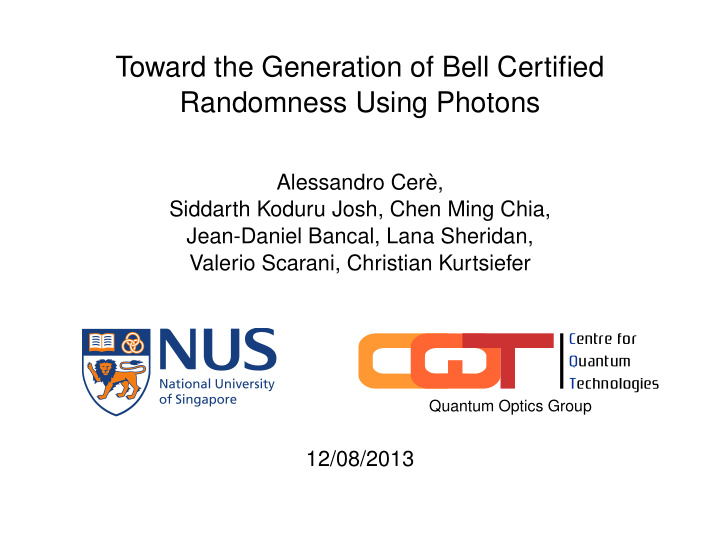



Toward the Generation of Bell Certified Randomness Using Photons Alessandro Cerè, Siddarth Koduru Josh, Chen Ming Chia, Jean-Daniel Bancal, Lana Sheridan, Valerio Scarani, Christian Kurtsiefer Quantum Optics Group 12/08/2013
Random is hard Randomness is hard to characterize statistical test can never complete Classical mechanics is deterministic there is no true randomness, only lack of knowledge. Quantum mechanics is based on randomness in real experiments we need to separate the genuine randomness from apparent randomness (noise, lack of knowledge).
Outline Certified randomness violating Bell inequality Bell’s test with photons polarization Closing the detection loophole Locality loophole
Outline Certified randomness violating Bell inequality Bell’s test with photons polarization Closing the detection loophole Locality loophole
Certification of randomness non local correlations of quantum states can be used to generate certified private randomness ∗ randomness private certified [*] S. Pironio et al., Nature 464 , 1021 (2010)
Non local correlation: violation of Bell inequality X A Y B Source 45° Y A � X B Bob Alice S = E ( X A , X B ) � E ( X A , Y B ) + E ( Y A , X B ) + E ( Y A , Y B ) if | S | > 2 there is no local-realistic description for the observed correlation
Loopholes in the experimental violation Detection minimum necessary efficiency larger than 2 / 3 Freedom of choice random choice of the measurement basis Locality spatial separation sufficient to exclude direct communication in the choice of the basis
Loopholes in the experimental violation locality (SPDC, fibres) Tittel et al. 1998 locality and freedom of choice (SPDC) Weihs et al. detection ( 9 Be + ions) 2001 Rowe et al. 2009 detection (Josephson phase qubits) Ansmann et al. detection (SPDC) Giustina et al. 2013 detection (SPDC) Christensen et al.
Outline Certified randomness violating Bell inequality Bell’s test with photons polarization Closing the detection loophole Locality loophole
Optimal state for real detectors With finite detection efficiency η the maximum violation ∗ is observed for a non-totally entangled state of the form: | ψ i = cos θ | HV i + sin θ | VH i with θ = θ ( η ) and a set of measurement basis appropriately chosen: X a = { cos α 1 H , sin α 1 V } Y a = { cos α 2 H , sin α 2 V } with α 1 , α 2 , β 1 , β 2 functions of η X b = { cos β 1 H , sin β 1 V } Y b = { cos β 2 H , sin β 2 V } [*] P . H. Eberhard, Phys. Rev. A 47, R747 (1993)
Bell’s test with two detectors Using an appropriate time binning it is possible to use only two detectors instead of four. For every time bin Alice and Bob assign a value to the measurement: -1 single detection event no detection events +1 multiple detection events The optimal time bin duration µ depends on the detected count rate.
Quantify randomness from Bell’s violation Random bits per run 0 10 �� 10 �� 10 With CHSH, biased inputs (reference) �� From the correlations with biased inputs 10 With CHSH and uniform choice of inputs From correlations and uniform choice of inputs �� 10 �� 0.66 0.8 0.9 1 detectors 10 efficiency We can extract more random bit per run than before.
Advantage of the new lower bound Unbiased choice of measurement basis Use of the full statistics (i.e. E’s), not only the correlation S Efficiency compared to standard case uniform basis, full statistics 2.6 2 uniform basis, CHSH biased inputs, full statistics 1.2 CHSH 1 detectors 0.66 0.8 0.9 1 efficiency
Outline Certified randomness violating Bell inequality Bell’s test with photons polarization Closing the detection loophole Locality loophole
Experimental setup | ψ i = cos θ | HV i + e i φ sin θ | VH i fiber TES APD calcite APD lens HWP dichroic HWP phase plate mirror calcite HWP@ 45° crystal fiber 405 nm TES dichroic coincidence mirror logic HWP @ 45° lens HWP PBS
Optimal pump focus for collection efficiency 1 0.85 Corrected for detector efficiency 0.67 pair efficiency AR coated fiber 0.38 0 0 100 170 200 300 400 ���������������������
Measuring TES efficiency C p Pairs efficiency η = S 1 S 2 = 0 . 742 ± 0 . 007 10000 coincidence window ��� 8000 ������������� 6000 ���������� 4000 2000 0 0 0.5 1 1.5 2 �������������������� Including an estimation of the losses ) TES efficiency > 0.93
Closing the detection loophole: table of efficiency η pairs generation and collection 0.85 polarization projection 0.97 intrinsic 0.99 fiber transmission splices 0.94 detection 0.93 Total 0 . 71 > 0 . 667
Outline Certified randomness violating Bell inequality Bell’s test with photons polarization Closing the detection loophole Locality loophole
Fast polarization modulator 0 200 ����� 0 control control voltage PBS 1 V 120 V drive driver voltage 0 MgO:LiNbO H 3 polarization PBS L Detector V ���������
Timing considerations time (ns) Alice Bob signaling zone 315 detection 250 basis choice 150 random 115 number photon pairs 0 -50 -45 45 50 m 0
Summary • Using the full statistic we can extract more randomness • Efficient source of polarization entangled photon pairs • State of the art detection technologies allow us to overcome the detection loophole • Fast polarization switch allows reasonable distances and rates Outlook • Improve the detection speed • Include the fast polarization switch in the setup
Recommend
More recommend